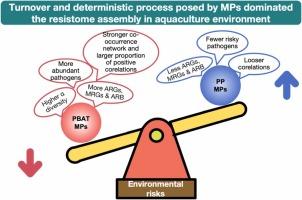Biodegradable microplastics amplify antibiotic resistance in aquaculture: A potential One Health crisis from environment to seafood
IF 11.3
1区 环境科学与生态学
Q1 ENGINEERING, ENVIRONMENTAL
引用次数: 0
Abstract
Aquaculture has become a reservoir for antibiotic resistance genes (ARGs) and microplastics (MPs), threatening food security and human health. However, the role of MPs, in ARGs dissemination remains unclear. Here, we tracked ARGs dynamics in tilapia aquaculture systems via a 90-day in situ MPs-exposure experiment, and compared the impacts of conventional polypropylene MPs (PP-MPs) and biodegradable poly (butylene adipate-co-terephthalate) MPs (PBAT-MPs) on resistome distribution, ecological risks, and microbial assembly across water, sediment, plastisphere, and fish guts via metagenomics. Results revealed the MPs served as microbial scaffolds, enriching microbiome and resistome. Species turnover (>80%) and deterministic process induced by MPs dominated the microbial community assembly. Astonishingly, PBAT-MPs posed higher risks compared to PP-MPs based on risks ranking (Rank I ARGs and risk index) and pathogen identification (37% and 34% of clinical ARGs, respectively). Stronger correlations were built in plastisphere between the microbial communities and ARGs (r > 0.8 and p < 0.05). Microbes (path coefficient = 0.632, p < 0.01) and MGEs (path coefficient = 0.344, p < 0.01) jointly exerted positive correlations with the ARGs profile. With sediments and MPs functioning ARGs reservoir and vectors, resistome dissemination mediated by plastisphere biofilm evolution were potentially exacerbated through trophic accumulation. By integrating multi-compartment resistome mapping (sediment reservoir-MPs vector-fish exposure), we established MPs as amplifiers of ARGs across trophic chains, directly linking environmental dynamics to human dietary exposure risks, thereby advancing environmental sustainability, food safety and antimicrobial resistance governance under One Health Perspective.

可生物降解的微塑料增强了水产养殖中的抗生素耐药性:从环境到海鲜的潜在健康危机
水产养殖已成为抗生素耐药基因(ARGs)和微塑料(MPs)的储存库,威胁着粮食安全和人类健康。然而,MPs在ARGs传播中的作用仍不清楚。本研究通过90天的原位MPs暴露实验,跟踪了罗非鱼养殖系统中ARGs的动态,并通过元基因组学比较了传统聚丙烯MPs (PP-MPs)和可生物降解聚(丁二酸-对苯二甲酸酯)MPs (pbatmp)对水、沉积物、塑料球和鱼类肠道中抵抗组分布、生态风险和微生物聚集的影响。结果表明,MPs可作为微生物支架,丰富微生物组和抵抗组。物种更替(>80%)和MPs诱导的确定性过程主导了微生物群落组装。令人惊讶的是,基于风险排名(一级arg和风险指数)和病原体鉴定(分别占临床arg的37%和34%),PBAT-MPs比PP-MPs具有更高的风险。在塑料圈中,微生物群落与ARGs之间存在较强的相关性(r >; 0.8和p <; 0.05)。微生物(通径系数= 0.632,p < 0.01)和MGEs(通径系数= 0.344,p < 0.01)共同与ARGs谱呈正相关。沉积物和MPs作为ARGs的储存库和载体,可塑性球生物膜进化介导的抵抗组传播可能通过营养积累而加剧。通过整合多室抗性组图谱(沉积物水库-MPs载体-鱼类暴露),我们建立了MPs作为营养链上ARGs的放大器,直接将环境动态与人类饮食暴露风险联系起来,从而在一个健康视角下推进环境可持续性、食品安全和抗菌素耐药性治理。
本文章由计算机程序翻译,如有差异,请以英文原文为准。
求助全文
约1分钟内获得全文
求助全文
来源期刊

Journal of Hazardous Materials
工程技术-工程:环境
CiteScore
25.40
自引率
5.90%
发文量
3059
审稿时长
58 days
期刊介绍:
The Journal of Hazardous Materials serves as a global platform for promoting cutting-edge research in the field of Environmental Science and Engineering. Our publication features a wide range of articles, including full-length research papers, review articles, and perspectives, with the aim of enhancing our understanding of the dangers and risks associated with various materials concerning public health and the environment. It is important to note that the term "environmental contaminants" refers specifically to substances that pose hazardous effects through contamination, while excluding those that do not have such impacts on the environment or human health. Moreover, we emphasize the distinction between wastes and hazardous materials in order to provide further clarity on the scope of the journal. We have a keen interest in exploring specific compounds and microbial agents that have adverse effects on the environment.
 求助内容:
求助内容: 应助结果提醒方式:
应助结果提醒方式:


